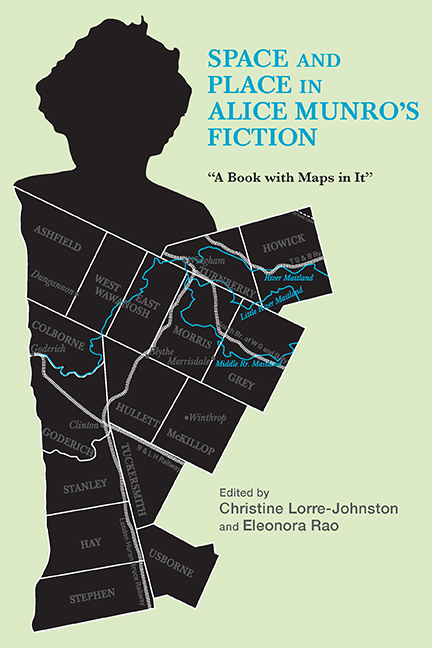Book contents
- Frontmatter
- Contents
- List of Illustrations
- Acknowledgments
- List of Abbreviations
- Introduction
- Part I Conceptualizing Space and Place: Houses, Landscapes, Territory
- Part II Close Readings of Space and Place
- 8 Spaces of Utopia and Spaces of Actuality in Alice Munro's “Jakarta”
- 9 Spatial Perspectives in Alice Munro's “Passion”
- 10 Charting Alice Munro's Terra Incognita: Punctuated Space in “Free Radicals”
- 11 Heterotopy in Alice Munro's “In Sight of the Lake”
- Bibliography
- Notes on the Contributors
- Index
9 - Spatial Perspectives in Alice Munro's “Passion”
from Part II - Close Readings of Space and Place
Published online by Cambridge University Press: 15 August 2018
- Frontmatter
- Contents
- List of Illustrations
- Acknowledgments
- List of Abbreviations
- Introduction
- Part I Conceptualizing Space and Place: Houses, Landscapes, Territory
- Part II Close Readings of Space and Place
- 8 Spaces of Utopia and Spaces of Actuality in Alice Munro's “Jakarta”
- 9 Spatial Perspectives in Alice Munro's “Passion”
- 10 Charting Alice Munro's Terra Incognita: Punctuated Space in “Free Radicals”
- 11 Heterotopy in Alice Munro's “In Sight of the Lake”
- Bibliography
- Notes on the Contributors
- Index
Summary
Idle Travellers,
Inquisitive Travellers,
Lying Travellers,
Proud Travellers,
Vain Travellers,
Splenetic Travellers.
Then follow
The Travellers of Necessity,
The delinquent and felonious Traveller,
The unfortunate and innocent Traveller,
The simple Traveller,
And last of all (if you please) the Sentimental Traveller (meaning thereby myself) who have travelled, and of which I am now sitting down to give an account—as much of Necessity, and the besoin de Voyager, as any one in the class.
—Laurence Sterne, A Sentimental Journey through France and ItalyIN A SENTIMENTAL JOURNEY THROUGH FRANCE AND ITALY (1768), Laurence Sterne provides a list of various categories of travelers: one can travel for pride, curiosity, vanity, or impatience, because of legal problems, to go into exile, or for the simple pleasure of traveling. The list ends with the figure of the “Sentimental Traveller” for whom travelling is an interior necessity, an urgent need, a search for new experiences and spurs. Therefore, from this perspective, the sentimental journey gains an instructive function and becomes a journey of self-realization, different from the Grand Tour. The latter was first popular among late fifteenth-century English scholars who travelled across France, Germany, Switzerland, and Italy, seeking manuscripts, books, and great sites of antiquity. In the eighteenth century, however, the Grand Tour became indispensable for any wealthy young man who wanted to enjoy both the artistic and natural beauties offered by continental cities. Sterne thus distorts the sense of travel literature and pushes art, landscape, and traditions into the background, focusing on the traveler's perceptions and on the emotional impact of the journey on the self. In “Passion,” one of the stories in the collection Runaway (2004), Alice Munro combines these two dimensions of a journey and creates a dynamic alternation between external geographies and interior spaces. Focusing on this dynamic process that binds internal and external spaces, I will examine the role of memory in the perception of space, and the way the apprehension of remembered space is crucial to the process of reflecting actively on one's life.
- Type
- Chapter
- Information
- Space and Place in Alice Munro's Fiction“A Book with Maps in It”, pp. 171 - 182Publisher: Boydell & BrewerPrint publication year: 2018



